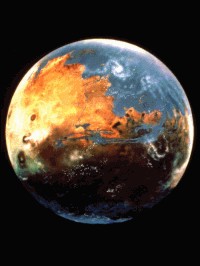
Michael Carroll's website is at www.spacedinoart.com
THE TERRAFORMING ART GALLERY.
Many space artists have depicted terraforming scenes in their work.
 |
Mars, as terraformed by Michael Carroll. If
we really could come up with all that water, it would drain to the
northern plains and form an ocean covering up to 25% of the planet. In
1991 this image was used on the front cover of the 'Making Mars Habitable'
issue of Nature.
Michael Carroll's website is at www.spacedinoart.com |
 |
A terraformed Mars as seen from Phobos, by
David A. Hardy. This picture was used for the front cover of Arthur C.
Clarke's book 'The Snows of Olympus: A Garden on Mars.'
David Hardy's web site is at http://www.hardyart.demon.co.uk |
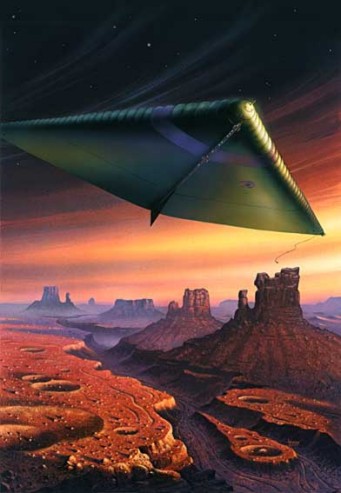 |
Aerial exploration of a dry valley on
Mars. This painting, by David A. Hardy, depicts the dirigible airship Arrowhead
described in Kim Stanley Robinson's novel 'Red Mars'. Designed as a cover,
the picture graced the front of Interzone as well as that of an edition of
the novel itself.
Stan Robinson described the Arrowhead as being 100 m long and 120 m wide across the wings, with a pencil-shaped gondola extended under most of the length of the underside. Flight is achieved in the thin air on Mars by buoyant hydrogen within the body of the craft, lift from the wings and turboprops at each wing tip and under the gondola. David Hardy's web site is at http://www.hardyart.demon.co.uk |
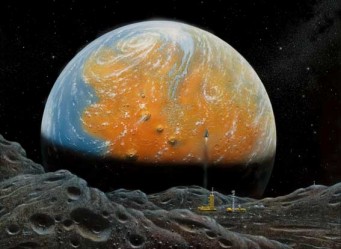 |
Another book cover by Hardy for Carl
Sagan's 'Pale Blue Dot'. Again, we see Mars from Phobos: a planet at an
advanced stage of terraforming with the Tharsis volcanoes, a flooded
Mariner Valley and the Boreal Ocean clearly and accurately portrayed.
David Hardy's web site is at http://www.hardyart.demon.co.uk |
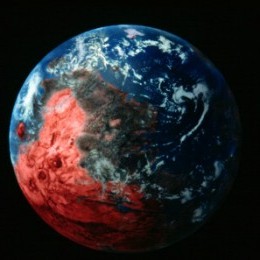 |
Another nice image of a terraformed
Mars, look at the clouds and the blue of that sea!
This image was passed to me by NASA students but its provenance is unknown. Please alert me if you have the artist's details so he or she can be cited here. |
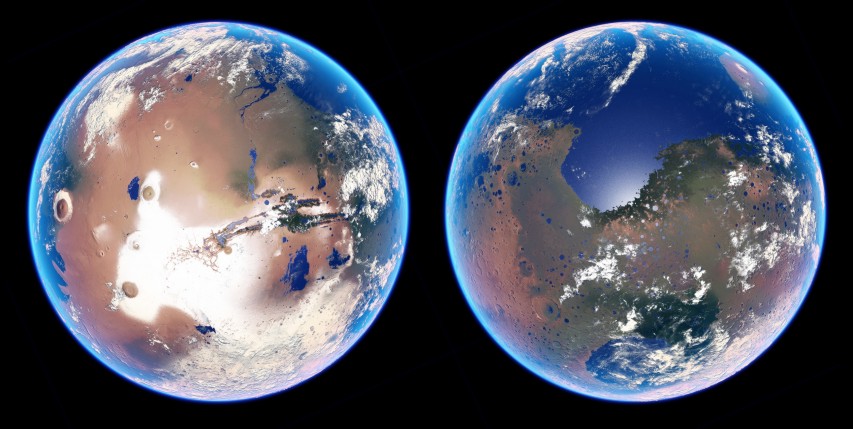 |
Fantastic images of the
"Tharsis" and "Hellas" hemispheres of a terraformed
Mars, rendered as if viewed from the altitude of Deimos's orbit.
Created by Darren Glidden using MOLA data manipulated in Adobe Photoshop. I love the detail such as an ice cap atop the Tharsis bulge and the green of vegetation on the shores of the Hellas and Isidis Seas. |
 |
This well known painting by
Michael Carroll depicts a "Terraforming Survey Team" examining
an ecosystem taking root on Mars. Planetary engineering is evidently
boosting the atmospheric pressure: hence the wearing of masks instead of
full pressure suits.
Michael Carroll's website is at www.spacedinoart.com |
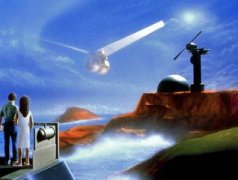 |
On the shores of the Great Boreal Ocean,
beneath a blue sky. The ultimate dream of some terraformers: making a home
of Mars.
With permission of the artist, Julian Baum. http://www.julianbaum.co.uk/index.html |
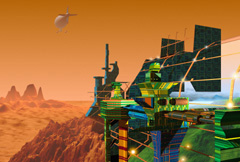 |
The Mars Worldhouse: a quasi-global
building conceived by Richard Taylor as a rapid solution for
"paraterraforming " Mars.
With permission of the artist, Julian Baum. http://www.julianbaum.co.uk/index.html |
These next two images come from the Millenium Mars Calendar by James M. Graham and Kandis Elliot: a calendar spanning one Mars year, divided into 20 "months", and based on a terraforming theme. Here's the link to find out more http://www.tomorrowsf.com/market/mars/welcome.html
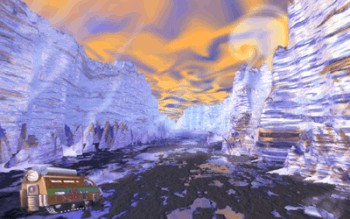 |
A research vehicle explores summer at the
South Pole of Mars by venturing into one of the wind-eroded canyons in the
ice cap.
Image reproduced with permission of K. Elliot. |
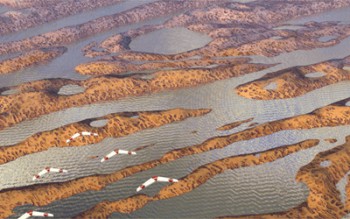 |
A valley system on Mars begins to flood as
terraforming proceeds. Fluvial erosion is seen on the Red Planet again for
perhaps the first time in a billion years.
Image reproduced with permission of K. Elliot. |
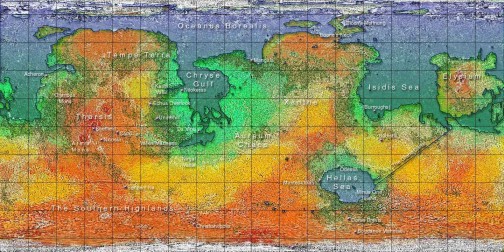 |
| A cylindrical projection of the terraformed Mars that results in Kim Stanley Robinson's novel "Blue Mars". For the detailed full sized image, visit Frans Blok's "Red, Green and Blue Mars Site". |
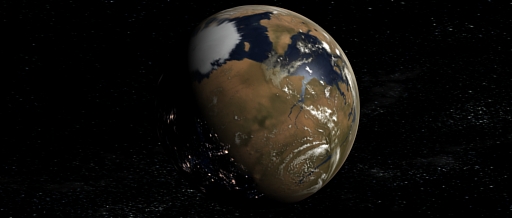 |
| Superb rendering of a terraformed Mars showing Tharsis, the North Polar Cap and the flooded Chryse Basin to the East. Notice the light of settlements on the dark hemisphere. Image by University of Southern California student Eric Anderson. |
The availability of 3D landscape rendering software, such as Vistapro and Bryce 3D now allows amateurs to have a go at this art-form. Here are some examples of my own Bryce 3D output.
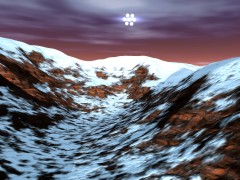 |
A Zubrin statite mirror cluster warms the South Pole of Mars in order to liberate its frozen atmosphere. |
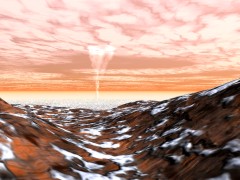 |
It is possible that substantial water reserves might be released during terraforming by drilling into pressurized aquifers beneath the northern plains. Here, from the crest of the southern uplands, we see a huge geyser erupting in the distance. frost is already condensing nearby. |
Illustrations of more exotic planetary engineering projects are welcome.
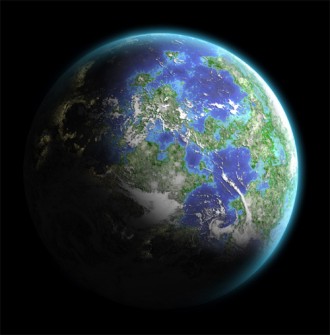 |
Believe it or not, but it is just possible to terraform the Earth's moon, so long as you are prepared to keep its imported volatiles topped up every few thousand years or so! It is probably impractical, but what a fine sight such a blue moon would be from the surface of the Earth. This stunning image was created by Pierre Davies from an ordinary photograph of the moon, heavily modified in Photoshop. |
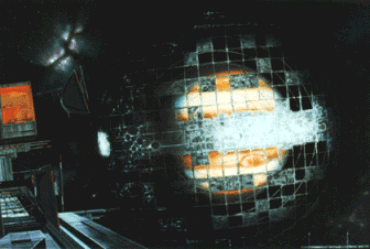 |
A supramundane planet under construction
over Jupiter according to the concept of Paul Birch. The vast habitable
strip over the tropical regions, supported by a cage of dynamic
compression members, could be extended to englobe the entire planet. Built
at the 1 g level, its surface area would be up to 316 Earths.
Image by Mamoru Ito, from Shoji and Ikkie Hasegawa's Space Art web pages http://svr1.hkisl.net/~shoji/html/terra1.html |